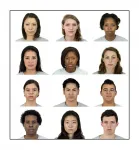(Press-News.org) DURHAM, N.C. -- You enter a room and quickly scan the crowd to gain a sense of who's there - how many men versus women. How reliable is your estimate?
Not very, according to new research from Duke University.
In an experimental study, researchers found that participants consistently erred in estimating the proportion of men and women in a group. And participants erred in a particular way: They overestimated whichever group was in the minority.
"Our attention is drawn to outliers," said Mel W. Khaw, a postdoctoral research associate at Duke and the study's lead author. "We tend to overestimate people who stand out in a crowd."
For the study, which appears online in the journal Cognition, researchers recruited 48 observers ages 18-28. Participants were presented with a grid of 12 faces and were given just one second to glance at the grid. Study participants were then asked to estimate the number of men and women in the grid.
Participants accurately assessed homogenous groups - groups containing all men or all women. But if a group contained fewer women, say, participants overestimated the number of women present.
The researchers also tracked participants' eye movements. They found that participants looked more often at whichever group was in the minority - men or women.
All of this occurred very quickly -- during a glance of just one second, said co-author and Duke psychologist Scott Huettel.
"We should recognize that our visual system is set up to orient ourselves towards some types of information more than others," Huettel said. "People form an initial impression very quickly,
and that impression biases where we look next."
Interestingly, the same tendency to focus on the outlier also extended to scanning other kinds of images.
In a second experiment, study participants were shown a grid of nature photos showing a variety of indoor and outdoor scenes. Participants consistently overestimated whatever type of scene appeared less often.
For instance, if a grid of 12 photos contained two outdoor scenes - say, a waterfall and a mountain range -- participants reported, on average, that the grid contained three such scenes.
In other words, the same behavior occurred whether people were looking at faces or scenes. That's important, Huettel said.
"That fact that this occurs with indoor and outdoor scenes suggests that this doesn't represent a social bias," Huettel said. "It really has to do with a fundamental feature of human perception."
And that built-in flaw in human perception suggests our quick judgments should be viewed with caution.
"Snap judgments are powerful," Huettel said. "But they're not perfect."
Co-author Rachel Kranton, an economist, noted that as the research was coming together, she received an invitation to an economics conference including a photo from a past event.
The photo showed a meeting room full of mostly men, a situation Kranton frequently encounters at economics conferences. Kranton said she found herself scanning the photo for the presence of women -- and smiling in recognition.
"When human beings walk into a social situation, we immediately try to suss out the setting," Kranton said. "We scan to see who's there and how we fit in - that's a common human experience. It's one I've experienced many times."
INFORMATION:
The research was supported by a grant from the National Institute of Mental Health (NIMH R01-108627; S.H.).
CITATION: "Oversampling of Minority Categories Drives Misperceptions of Group Compositions," Mel W. Khaw, Rachel Kranton and Scott Huettel. Cognition, Vol. 214, September 2021.
DOI: 10.1016/j.cognition.2021.104756
Researchers from the Cleveland Clinic and Takeda Pharmaceutical Company conducted a study to evaluate the effectiveness of shared medical appointments for people with pre-diabetes compared with a group of patients receiving usual care. Shared medical appointments are typically delivered in a medical clinic by physicians and other health care providers. Within the context of this study, shared medical appointments consisted of patients consulting with their doctors one-on-one and then joining a group of similar patients to set goals and review lab results with the same family ...
Between 11% to 40% of adults in the United States experience chronic pain, and primary care physicians may feel ill-equipped to effectively and safely care for patients with chronic pain, addiction or both. Researchers from Tufts University conducted a study to evaluate the effectiveness of an interdisciplinary consultation service that supports primary care physicians who care for patients experiencing chronic pain and addiction. The goal was to identify new and effective strategies that clinics can use to support PCPs.
From that interdisciplinary consultation service, the researchers collected ...
Bacteria that move around live on the edge. All the time. Their success, be it in finding nutrients, fending off predators or multiplying depends on how efficiently they navigate through their confining microscopic habitats. Whether these habitats are in animal or plant tissues, in waste, or in other materials. In a recent paper published in PNAS, a team of researchers led by McGill University, has described a number of factors affecting how five, very different, species of bacteria search and navigate through varied microfluidic environments which pose various decisional challenges. This increased understanding of the bacterial space searching and navigational 'strategies' has implications ...
Antibiotics: Patient Expectations and Doctors' Prescribing Habits May Contribute to Antimicrobial Resistance
Inappropriate antibiotic prescribing for upper respiratory tract infections contributes to antibiotic resistance, making some bacterial infections difficult to treat. This often leads to higher medical costs, prolonged hospital stays and increased mortality. Still, many physicians report prescribing antibiotics at their patients' request. To address patients' expectations for antibiotic prescribing for URTIs, researchers conducted an experiment in which study participants were assigned brief educational videos to watch on a tablet immediately prior to their appointment.
The authors randomized patients into three groups - one that viewed a presentation about ...
Skoltech scientists have created a new monitoring system for agricultural applications that performs real-time image segmentation on board the drone to identify hogweed. The research was published in a high-profile journal, IEEE Transactions on Computers.
Sosnovsky's hogweed is equally hazardous for farming, local ecosystems, and human health. Direct contact with human skin, especially if aggravated by exposure to the Sun, causes severe burns that require continuous medical care and take weeks to heal. The rampant spread of Sosnovsky's hogweed has become a real environmental disaster that extends across the whole of ...
Individuals with diabetes are at greater risk of developing oral health issues, like gum disease, yet care for these linked health issues are usually disconnected, split between primary care and dental care. A research team from the University of Amsterdam developed an intervention that provided primary care-based oral health information and dental referrals for patients with diabetes. In a cluster randomized controlled trial, 764 patients from 24 primary care practices received either the oral health support or standard primary care. Participants were asked to rate their oral health quality of life, as well as their general health and any oral health complaints, at the start and end of the study. Analysis showed that individuals who received the primary care-based oral health support ...
Though different fabrication approaches exist, two-step deposition is one of the main experimental techniques now used to make efficient, stable PSCs, especially on the industrial scale. The process involves first depositing lead iodide (PbI2) and then adding halide salts of monovalent cations such as methylammonium iodide (MAI) and formamidinium iodide (FAI) to convert it to perovskite.
While this two-step deposition is better than other options, it is difficult to maintain reproducible high performance and long-term stability when scaling up, mostly because of a lack ...
EAST LANSING, Mich. - An acute loss of smell is one of the most common symptoms of COVID-19, but for two decades it has been linked to other maladies among them Parkinson's disease and dementia. Now, a poor sense of smell may signify a higher risk of pneumonia in older adults, says a team of Michigan State University researchers.
"About a quarter of adults 65 years or older have a poor sense of smell," said Honglei Chen, a professor in the Department of Epidemiology and Biostatistics within MSU's College of Human Medicine. "Unlike vision or hearing impairment, this sensory deficit has been largely neglected; more than two-thirds of people with a poor sense of smell do not know they have it."
In a first-of-its-kind study, Chen and his team found a possible link ...
Simon Fraser University researchers have designed a remarkably fast engine that taps into a new kind of fuel -- information.
The development of this engine, which converts the random jiggling of a microscopic particle into stored energy, is outlined in research published this week in the END ...
Scientists now better understand early bacterial evolution, thanks to new research featuring University of Queensland researchers.
Bacteria comprise a very diverse domain of single-celled organisms that are thought to have evolved from a common ancestor that lived more than three billion years ago.
Professor Phil Hugenholtz, from the Australian Centre for Ecogenomics in UQ's School of Chemistry and Molecular Biosciences, said the root of the bacterial tree, which would reveal the nature of the last common ancestor, is not agreed upon.
"There's great debate about the root of this bacterial tree of life and indeed whether bacterial evolution should even be described as a tree has been contested," Professor ...




